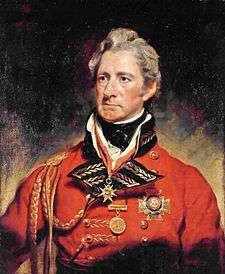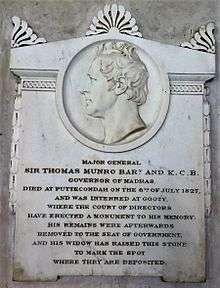Sir Thomas Munro, 1st Baronet
| Major-General Sir Thomas Munro, Bt KCB | |
|---|---|
 | |
| Governor of Madras | |
|
In office 16 September 1814 – 10 July 1827 | |
| Governor-General |
The Marquess of Hastings The Earl Amhurst |
| Preceded by | Sir George Barlow, Bt |
| Succeeded by | Stephen Rumbold Lushington |
| Personal details | |
| Born |
27 May 1761 Glasgow, Scotland |
| Died |
6 July 1827 (aged 65) Pattikonda, Madras Presidency, British India (now: Pattikonda, Kurnool district, Andhra Pradesh)[1] |
| Nationality | British |
| Alma mater | University of Glasgow |
| Awards | KCB |
| Military service | |
| Allegiance |
|
| Service/branch | Madras Army |
| Years of service | 1779–1827 |
| Rank | Major-General |
| Battles/wars |
Second Anglo-Mysore War Third Anglo-Mysore War Third Anglo-Maratha War |
_-_Copy.jpg)

Major-general Sir Thomas Munro, 1st Baronet KCB (27 May 1761 – 6 July 1827) was a Scottish soldier and colonial administrator. He was an East India Company Army officer and statesman.
Lineage
Munro was born in Glasgow on 27 May 1761 to a merchant called Alexander Munro. Thomas' grandfather was a tailor, who prospered by successful investments in American tobacco. After working as a bank clerk, Alexander Munro joined the family's prosperous tobacco business, but was ruined by the collapse of the tobacco trade during the American Revolutionary War.[3] Thomas was also said to be a direct descendant of George Munro, 10th Baron of Foulis (d.1452), chief of the Highland Clan Munro, [4] but clan historian R.W. Munro contested this claim.
Education and sport
Thomas was educated at the University of Glasgow. While at school, Thomas was distinguished for a singular openness of temper, a mild and generous disposition, with great personal courage and presence of mind. Being naturally of a robust frame of body, he surpassed all his school-fellows in athletic exercises, and was particularly eminent as a boxer. He was at first intended to enter his father's business, but in 1779 was appointed to an infantry cadet ship in Madras.[5]
Military career
He served with his regiment during the hard-fought war against Haidar Ali (1780–1783), serving under his older and distant relation Major Sir Hector Munro, 8th of Novar.[6] Thomas also later served alongside a younger distant relation John Munro, 9th of Teaninich.[7] Thomas served again with his regiment in the first campaign against Tipu Sultan (1790–1792). He was then chosen as one of four military officers to administer the Baramahal, part of the territory acquired from Tipu, where he remained for seven years learning the principles of revenue survey and assessment which he afterwards applied throughout the presidency of Madras.[8]
After the final downfall of Tipu in 1799, he spent a short time restoring order in Kanara; and then for another seven years (1800–1807) he was placed in charge of the northern districts ceded by the Nizam of Hyderabad, where he introduced the ryotwari system of land revenue.[8]
After a long furlough in Britain, during which he gave valuable evidence upon matters connected with the renewal of the British East India Company's charter, he returned to Madras in 1814 with special instructions to reform the judicial and police systems.[8]
On the outbreak of the Pindari War in 1817, he was appointed as brigadier-general to command the reserve division formed to reduce the southern territories of the Peshwa. Of his services on this occasion Lord Canning said in the House of Commons:
He went into the field with not more than five or six hundred men, of whom a very small proportion were Europeans .... Nine forts were surrendered to him or taken by assault on his way; and at the end of a silent and scarcely observed progress he emerged... leaving everything secure and tranquil behind him.[8]
In 1819 Munro was appointed a Knight Commander of the Order of the Bath (KCB).[9]
Memorial Pillar
Sir Thomas Munro memorial Pillar is situated in Dharmapuri district.The Pillar height is 20 feet.It is a concrete structure. When Thomas Munro worked in East India Company he was appointed in Revenue superintendent in Dharmapuri during 1792-1799.This Pillar was erected due to his welfare activities to the people of dharmapuri.
Governor of Madras
In 1819, he was appointed governor of Madras, where he founded systems of revenue assessment and general administration which substantially persisted into the twentieth century. He is regarded as the father of the 'Ryotwari system'. His official minutes, published by Sir A. Arbuthnot, form a manual of experience and advice for the modern civilian. Munro was created a Baronet, of Lindertis in the County of Forfar, in 1825.[10] He died of cholera on 6 July 1827 while on tour in the ceded districts, where his name is preserved by more than one memorial. An equestrian statue of him, by Francis Legatt Chantrey, stands in Madras city.[8]At his behest a Committee of public instruction was formed in 1826, which eventually led to the formation of Presidency College.[11]
Incidents at Mantralayam and Gandi (Andhra Pradesh)

Mantralayam village in Andhra Pradesh is a place where the `Brindavan' of famous 'Dvaita' saint 'Raghavendra Swami' is located. When Sir Thomas Munro was the Collector of Bellary in 1800, the Madras Government ordered him to procure the entire income from the Math and Manthralaya village.[12][13]When the Revenue officials were unable to comply with this order, Sir Thomas Munro visited the Math for investigation. He removed his hat and shoes and entered the sacred precincts. Sri Raghavendraswamy emerged from the Vrindavan and conversed with him for some time, about the resumption of endowment. The Saint was visible and audible only to Munro, who received Mantraskata (God's blessing).[14] The Collector went back and wrote an order in favour of the Math and the village. This notification was published in the Madras Government Gazette in Chapter XI, page 213, with the caption "Manchali Adoni Taluka". This order is still preserved in Fort St. George and Mantralayam.[15][16][17]
Gandi Kshetram is located in Kadapa district of today's state of Andhra Pradesh in India. It is known for its Veeraanjaneya temple, dedicated to Lord Hanuman. It is believed that the main deity in the temple is a picture that was drawn by none other than Lord Rama, the protagonist of the great Indian epic, Ramayana, with the tip of his arrow. As the auspicious minutes to return to Ayodhya were closing, he left in a hurry in the Pushpaka Vimana, leaving the portrait unfinished. The non-existent little toe on the main deity's left leg corroborates this fact. The River Papaghni flows through the gap between the two hills where this temple is located. It is believed that Vayu Deva, the Wind God built an arch of mango leaves in gold from one hill to the other to welcome Lord Rama and his brother Lakshmana, when they were returning to Ayodhya after killing the demon King Ravana in Lanka. It is said that this arch exists to this day and can be seen only by great and the most virtuous human beings.
When Sir Munro was the Collector of DattaMandalam in the Madras Provinces in the eighteenth century, he was able to notice this golden arch with his eyes. This rarest occurrence was recorded in the Kadapa Gazette and was noted in Sir Munro's diary as well, by himself.
Statue
Sculpted by Francis Chantrey, and sitting proud and straight on his horse, in the middle of Chennai's famed Island, is The Stirrupless Majesty.[18] Either due to an oversight, or depicting his affinity for bareback riding, Sir Thomas Munro's statue shows him without saddle and stirrup.[19] It has been recently reported that this statue will be removed.[20]
See also
Notes
- ↑ Bradshaw, John (1893). Sir Thomas Munro and the British settlement of the Madras Presidency. London: Oxford University Press. pp. 210–212.
- ↑ MacLeod, Norman (1871). Peeps at the Far East: A Familiar Account of a Visit to India. London: Strahan & Co. Retrieved 2 November 2015.
- ↑ McLaren 2001, pp. 15–16.
- ↑ Mackenzie 1898, p. 359 – 376 and p.342.
- ↑ Major-General Sir Thomas Munro, retrieved November 2011 Check date values in:
|accessdate=(help) - ↑ Mackenzie 1898, p. 369.
- ↑ Mackenzie 1898, pp. 427–430.
- 1 2 3 4 5 Chisholm 1911.
- ↑ "No. 17540". The London Gazette. 30 November 1819. p. 2146.
- ↑ "No. 18151". The London Gazette. 2 July 1825. p. 1155.
- ↑ "Presidency College: The Origin and Growth".
- ↑ H. K. Vedavyasacharya. Jagadguru Sri Raghavendra Swamy. Sri Parimala Research and Publishing House. p. 92.
- ↑ March of Karnataka, Volume 20. Director of Information and Publicity, Government of Karnataka. 1982. p. 17.
- ↑ Atasha Fyfe. Magic Past Lives: Reclaiming Your Secret Wisdom. Hay House Inc. p. 122. Retrieved 1 April 2013.
- ↑ The Hindu staff 2002.
- ↑ "Miracles performed by Guru Raghavendra". Retrieved November 2011. Check date values in:
|accessdate=(help) - ↑ Visvanatha Krishnamurthy. The Ten Commandments of Hinduism. Wiley Eastern Limited. p. 159. ISBN 9788122406283. Retrieved 1 January 1994. Check date values in:
|accessdate=(help) - ↑ Muthiah 2003.
- ↑ Gopalakrishnan 2006.
- ↑ Sriram, V. (26 July 2010). "Unsung hero of Madras". The Hindu.
References
- Gopalakrishnan, ChandraChoodan (23 March 2006), The stirrup-less majesty, Chennai Metblogs.com, retrieved November 2011 Check date values in:
|accessdate=(help) - Mackenzie, Alexander (1898), History of the Munros of Fowlis, pp. 369, 427–430
- McLaren, Martha (2001), British India & British Scotland, 1780–1830: Career Building, Empire Building, and a Scottish School of Thought on Indian Governance (PDF), University of Akron Press, ISBN 978-1-884836-73-2, archived from the original (PDF) on 15 May 2008
- Muthiah, S. (4 June 2003), Relics of Company times, The Hindu, retrieved November 2011 Check date values in:
|accessdate=(help) - The Hindu staff (18 October 2002), Manthralayam for that healing touch, Chennai, India: The Hindu, retrieved November 2011 Check date values in:
|accessdate=(help) - The Hindu staff (26 July 2010), "Unsung hero of Madras", The Hindu, Chennai, India, retrieved November 2011 Check date values in:
|accessdate=(help)
- Attribution

Further reading
- "Munro, Sir Thomas". Oxford Dictionary of National Biography (online ed.). Oxford University Press. doi:10.1093/ref:odnb/19549. (Subscription or UK public library membership required.)

- Harrington, Jack (2010), Sir John Malcolm and the Creation of British India, Chs. 2 & 5., New York: Palgrave Macmillan., ISBN 978-0-230-10885-1
- Stein, Burton (1990), Thomas Munro: The Origins of the Colonial State and his Vision of Empire, Oxford University Press, ISBN 0-19-562331-2
| Political offices | ||
|---|---|---|
| Preceded by Hugh Elliot |
Governor of Madras 1820–1827 |
Succeeded by Henry Sullivan Graeme (acting) |
| Baronetage of the United Kingdom | ||
| Preceded by New creation |
Baronet (of Lindertis) 1825–1827 |
Succeeded by Thomas Munro |